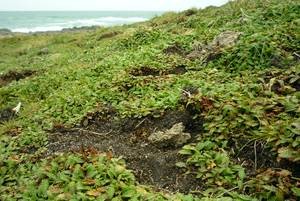 Olearia lineata bark damage by deer. Photo: Jesse BythellOver 23 introduced mammal species occur in New Zealand and have had major impacts on New Zealand’s native biota. The absence of terrestrial, four-footed mammals from New Zealand until a few centuries ago has meant that our native fauna evolved within a terrestrial ecosystem dominated by birds. These species now experience an intensity of predation and competition far beyond their evolutionary ability to tolerate. Accordingly much of New Zealand’s biota has suffered, and extinctions, particularly of animals have been severe. Today, New Zealand’s land based native mammal species (three species of bat, one now extinct) are far outnumbered by introduced mammals.
Olearia lineata bark damage by deer. Photo: Jesse BythellOver 23 introduced mammal species occur in New Zealand and have had major impacts on New Zealand’s native biota. The absence of terrestrial, four-footed mammals from New Zealand until a few centuries ago has meant that our native fauna evolved within a terrestrial ecosystem dominated by birds. These species now experience an intensity of predation and competition far beyond their evolutionary ability to tolerate. Accordingly much of New Zealand’s biota has suffered, and extinctions, particularly of animals have been severe. Today, New Zealand’s land based native mammal species (three species of bat, one now extinct) are far outnumbered by introduced mammals.
Introduced animals are often classified as ecological pests because they impact detrimentally on the structure, function or composition of New Zealand’s indigenous plant communities.
 Cattle damage to a coastal turf community, which supports Lepidium tenuicaule. Photo: Jesse BythellFor more information see:
Cattle damage to a coastal turf community, which supports Lepidium tenuicaule. Photo: Jesse BythellFor more information see:
- King, C.E. (ed.) 2005. The handbook of New Zealand Mammals. Oxford University Press, Melbourne, Australia. Pp. 610.
